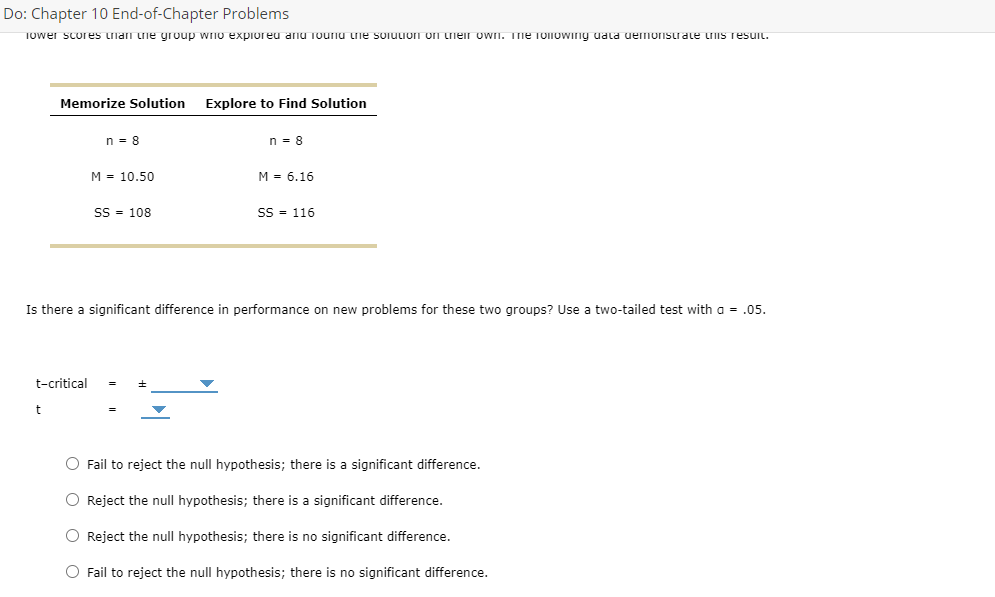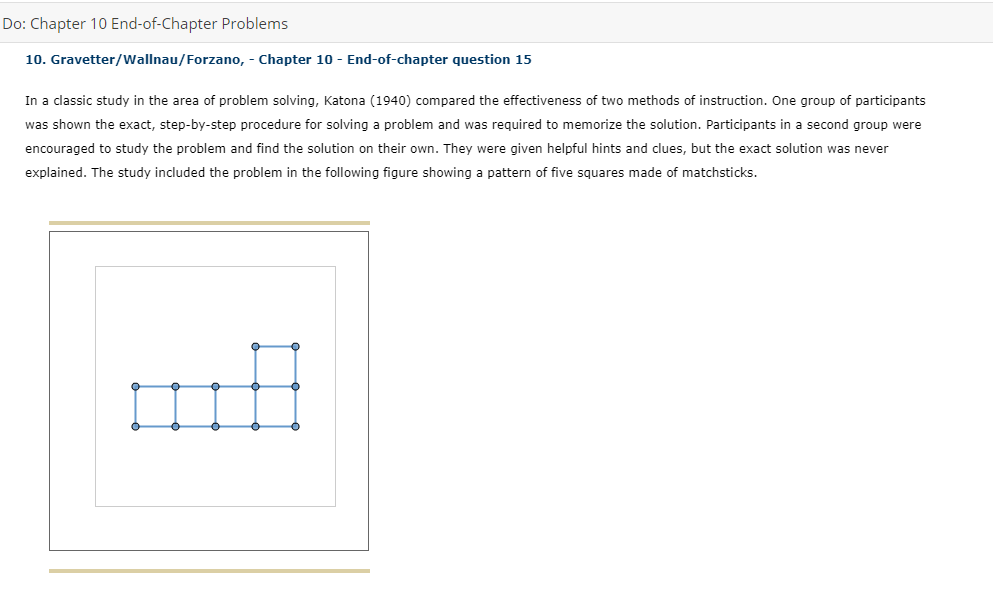In a classic study in the area of problem solving, Katona (1940) compared the effectiveness of two methods of instruction. One group of participants was shown the exact, step-by-step procedure for solving a problem and was required to memorize the solution. Participants in a second group were encouraged to study the problem and find the solution on their own. They were given helpful hints and clues, but the exact solution was never explained. The study included the problem in the following figure showing a pattern of five squares made of matchsticks. The problem is to change the pattern into exactly four squares by moving only three matches. (All matches must be used, none can be removed, and all the squares must be the same size.) After three weeks, both groups returned to be tested again. The two groups did equally well on the matchstick problem they had learned earlier. But when they were given new problems (similar to the matchstick problem), the memorization group had much lower scores than the group who explored and found the solution on their own. The following data demonstrate this result. Memorize Solution Explore to Find Solution n = 8 M = 10.50 SS = 108 n = 8 M = 6.16 SS = 116 Is there a significant difference in performance on new problems for these two groups? Use a two-tailed test with α = .05. t–critical = ± t = Fail to reject the null hypothesis; there is a significant difference. Reject the null hypothesis; there is a significant difference. Reject the null hypothesis; there is no significant difference. Fail to reject the null hypothesis; there is no significant difference. t Distribution Degrees of Freedom = 21 -3.0-2.0-1.00.01.02.03.0x Construct a 90% confidence interval to estimate the size of the mean difference. 0.818 to 7.862 2.579 to 6.101 2.340 to 6.340 0.340 to 8.340
In a classic study in the area of problem solving, Katona (1940) compared the effectiveness of two methods of instruction. One group of participants was shown the exact, step-by-step procedure for solving a problem and was required to memorize the solution. Participants in a second group were encouraged to study the problem and find the solution on their own. They were given helpful hints and clues, but the exact solution was never explained. The study included the problem in the following figure showing a pattern of five squares made of matchsticks. The problem is to change the pattern into exactly four squares by moving only three matches. (All matches must be used, none can be removed, and all the squares must be the same size.) After three weeks, both groups returned to be tested again. The two groups did equally well on the matchstick problem they had learned earlier. But when they were given new problems (similar to the matchstick problem), the memorization group had much lower scores than the group who explored and found the solution on their own. The following data demonstrate this result. Memorize Solution Explore to Find Solution n = 8 M = 10.50 SS = 108 n = 8 M = 6.16 SS = 116 Is there a significant difference in performance on new problems for these two groups? Use a two-tailed test with α = .05. t–critical = ± t = Fail to reject the null hypothesis; there is a significant difference. Reject the null hypothesis; there is a significant difference. Reject the null hypothesis; there is no significant difference. Fail to reject the null hypothesis; there is no significant difference. t Distribution Degrees of Freedom = 21 -3.0-2.0-1.00.01.02.03.0x Construct a 90% confidence interval to estimate the size of the mean difference. 0.818 to 7.862 2.579 to 6.101 2.340 to 6.340 0.340 to 8.340
Algebra: Structure And Method, Book 1
(REV)00th Edition
ISBN:9780395977224
Author:Richard G. Brown, Mary P. Dolciani, Robert H. Sorgenfrey, William L. Cole
Publisher:Richard G. Brown, Mary P. Dolciani, Robert H. Sorgenfrey, William L. Cole
Chapter9: Systems Of Linear Equations
Section9.3: Solving Problems With Two Variables
Problem 6P
Related questions
Question
10. Gravetter/Wallnau/Forzano, - Chapter 10 - End-of-chapter question 15
In a classic study in the area of problem solving, Katona (1940) compared the effectiveness of two methods of instruction. One group of participants was shown the exact, step-by-step procedure for solving a problem and was required to memorize the solution. Participants in a second group were encouraged to study the problem and find the solution on their own. They were given helpful hints and clues, but the exact solution was never explained. The study included the problem in the following figure showing a pattern of five squares made of matchsticks.
The problem is to change the pattern into exactly four squares by moving only three matches. (All matches must be used, none can be removed, and all the squares must be the same size.) After three weeks, both groups returned to be tested again. The two groups did equally well on the matchstick problem they had learned earlier. But when they were given new problems (similar to the matchstick problem), the memorization group had much lower scores than the group who explored and found the solution on their own. The following data demonstrate this result.
|
Memorize Solution
|
Explore to Find Solution
|
|---|---|
|
n = 8
M = 10.50
SS = 108
|
n = 8
M = 6.16
SS = 116
|
Is there a significant difference in performance on new problems for these two groups? Use a two-tailed test with α = .05.
| t–critical | = | ± |
| t | = |
Fail to reject the null hypothesis; there is a significant difference.
Reject the null hypothesis; there is a significant difference.
Reject the null hypothesis; there is no significant difference.
Fail to reject the null hypothesis; there is no significant difference.
t Distribution
Degrees of Freedom = 21
-3.0-2.0-1.00.01.02.03.0x
Construct a 90% confidence interval to estimate the size of the mean difference.
0.818 to 7.862
2.579 to 6.101
2.340 to 6.340
0.340 to 8.340

Transcribed Image Text:Do: Chapter 10 End-of-Chapter Problems
Tower scores tian ie group wrio expioreu ariu iournu ie soiuLuon on Lieir owrn. Tme iOIOWing uata uemoistrale tiis resuiL.
Memorize Solution
Explore to Find Solution
n = 8
n = 8
M = 10.50
M = 6.16
SS = 108
SS = 116
Is there a significant difference in performance on new problems for these two groups? Use a two-tailed test witha = .05.
t-critical
O Fail to reject the null hypothesis; there is a significant difference.
O Reject the null hypothesis; there is a significant difference.
O Reject the null hypothesis; there is no significant difference.
O Fail to reject the null hypothesis; there is no significant difference.

Transcribed Image Text:Do: Chapter 10 End-of-Chapter Problems
10. Gravetter/Wallnau/Forzano, - Chapter 10 - End-of-chapter question 15
In a classic study in the area of problem solving, Katona (1940) compared the effectiveness of two methods of instruction. One group of participants
was shown the exact, step-by-step procedure for solving a problem and was required to memorize the solution. Participants in a second group were
encouraged to study the problem and find the solution on their own. They were given helpful hints and clues, but the exact solution was never
explained. The study included the problem in the following figure showing a pattern of five squares made of matchsticks.
Expert Solution
This question has been solved!
Explore an expertly crafted, step-by-step solution for a thorough understanding of key concepts.
This is a popular solution!
Trending now
This is a popular solution!
Step by step
Solved in 2 steps with 2 images

Recommended textbooks for you

Algebra: Structure And Method, Book 1
Algebra
ISBN:
9780395977224
Author:
Richard G. Brown, Mary P. Dolciani, Robert H. Sorgenfrey, William L. Cole
Publisher:
McDougal Littell

Algebra for College Students
Algebra
ISBN:
9781285195780
Author:
Jerome E. Kaufmann, Karen L. Schwitters
Publisher:
Cengage Learning

Intermediate Algebra
Algebra
ISBN:
9781285195728
Author:
Jerome E. Kaufmann, Karen L. Schwitters
Publisher:
Cengage Learning

Algebra: Structure And Method, Book 1
Algebra
ISBN:
9780395977224
Author:
Richard G. Brown, Mary P. Dolciani, Robert H. Sorgenfrey, William L. Cole
Publisher:
McDougal Littell

Algebra for College Students
Algebra
ISBN:
9781285195780
Author:
Jerome E. Kaufmann, Karen L. Schwitters
Publisher:
Cengage Learning

Intermediate Algebra
Algebra
ISBN:
9781285195728
Author:
Jerome E. Kaufmann, Karen L. Schwitters
Publisher:
Cengage Learning